
The 49th International 500-Mile Sweepstakes was held at the Indianapolis Motor Speedway in Speedway, Indiana on Monday, May 31, 1965.

The 54th 500 Mile International Sweepstakes was held at the Indianapolis Motor Speedway in Speedway, Indiana on Saturday, May 30, 1970.

The 56th 500 Mile International Sweepstakes was held at the Indianapolis Motor Speedway in Speedway, Indiana, on Saturday, May 27, 1972. The race is notable in that for the first time, the cars were permitted bolt-on wings, and speeds climbed dramatically. Bobby Unser won the pole position at a then-remarkable speed of 195.940 mph (315.3 km/h) for four laps, breaking Peter Revson's track record of 178.696 mph (287.6 km/h) from 1971 by 17.244 mph (27.8 km/h) – the largest one-year track record increase in Indy history. The race average speed of 162.962 mph (262.3 km/h) was also a new record, which stood until 1984.
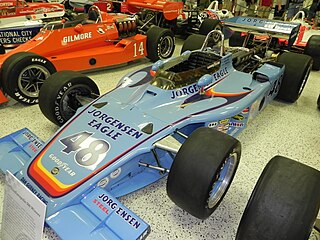
The 59th 500 Mile International Sweepstakes was held at the Indianapolis Motor Speedway in Speedway, Indiana on Sunday, May 25, 1975. A. J. Foyt started on the pole position and Bobby Unser won his second Indianapolis 500. Dan Gurney, one of the founders of All American Racers, who finished second as a driver himself in 1968–1969, won his first and only Indy 500 as a car owner. Gurney's Eagle chassis itself scored its third "500" win. The race was part of the 1975 USAC National Championship Trail.

The 60th 500 Mile International Sweepstakes was held at the Indianapolis Motor Speedway in Speedway, Indiana on Sunday, May 30, 1976. Polesitter Johnny Rutherford took the lead on lap 80, and was leading when rain halted the race on lap 103. Two hours later, the race was about to be resumed, but rain fell again. USAC officials called the race at that point, reverted the scoring back to the completion of lap 102, and Johnny Rutherford was declared the winner. Rutherford famously walked to Victory Lane, his second career Indy 500 triumph, having completed only 255 miles (410 km), the shortest official race on record. Janet Guthrie became the first female driver to enter the Indianapolis 500. However, her team was underfunded, and she experienced numerous mechanical and engine problems during the month. While she managed to pass her rookie test, and ran numerous practice laps in multiple cars, she was unable to make an attempt to qualify. She would return with a successful effort a year later in 1977.

The 61st 500 Mile International Sweepstakes was held at the Indianapolis Motor Speedway in Speedway, Indiana, on Sunday, May 29, 1977. Considered one of the most historically significant editions of the Indianapolis 500, several sidebar stories complemented the unprecedented accomplishment of race winner A. J. Foyt. Foyt became the first driver to win the Indianapolis 500 four times. As of 2024, Foyt's record has been tied by Al Unser Sr., Rick Mears and Hélio Castroneves, but still stands as an Indy 500 record. Foyt's victory is also the last time the winning car was built entirely within the United States.

The 62nd 500 Mile International Sweepstakes was held at the Indianapolis Motor Speedway in Speedway, Indiana on Sunday, May 28, 1978. Danny Ongais dominated the early stages of the race but eventually dropped out with a blown engine. Al Unser Sr. dominated the second half, and held a large lead late in the race. However, Unser bent the front wing of his Lola during a pit stop on lap 180, causing his handling to go away over the final twenty laps. Second place Tom Sneva charged to catch Unser's crippled Lola but came up 8 seconds short at the finish line – the second-closest finish in Indy history to that point. Unser held off the challenge, and became a three-time winner of the 500. It was Al Unser's third Indy victory in the decade of the 1970s, and the fifth of nine overall victories by the Unser family.
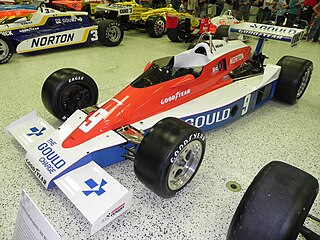
The 63rd 500 Mile International Sweepstakes was held at the Indianapolis Motor Speedway in Speedway, Indiana, on Sunday May 27, 1979. Second-year driver Rick Mears took the lead for the final time with 18 laps to go, and won his first of four Indianapolis 500 races. It was also Mears' first of a record six Indy 500 pole positions. Brothers Al and Bobby Unser combined to lead 174 of the 200 laps, but Al dropped out around the midpoint, and Bobby slipped to 5th place at the finish nursing mechanical issues. It was also Roger Penske's second Indy 500 victory as a car owner.

The 53rd International 500 Mile Sweepstakes was an auto race held at the Indianapolis Motor Speedway in Speedway, Indiana on Friday, May 30, 1969. It was the third round of the 1969 USAC Championship Car season. Polesitter A. J. Foyt led the race in the early stages, looking to become the first four-time winner of the 500. Near the halfway point, however, a lengthy pit stop to repair a broken manifold put him many laps down. Despite a hard-charging run towards the end, he wound up managing only an eighth-place finish, 19 laps down. Lloyd Ruby, a driver with a hard-luck reputation at the Speedway, was leading the race just after the midpoint. During a pit stop, he pulled away with the fueling hose still attached, ripped a hole in the fuel tank, and was out of the race. The incident put Mario Andretti in the lead for rest of the way.

The 64th 500 Mile International Sweepstakes was held at the Indianapolis Motor Speedway in Speedway, Indiana on Sunday, May 25, 1980. Johnny Rutherford won the pole position, led 118 laps, and won the race by a commanding 29.92 second margin. After failing to finish the race the year before, Jim Hall's radical new Chaparral 2K ground effects chassis was a heavy favorite entering the month, and drove a flawless race. Rutherford, the winner in 1974 and 1976, became the sixth driver to win the Indy 500 three times.
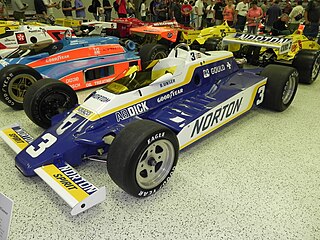
The 65th Indianapolis 500 was held at the Indianapolis Motor Speedway in Speedway, Indiana, on Sunday, May 24, 1981. The race is widely considered one of the most controversial races in Indy history. Bobby Unser took the checkered flag as the winner, with Mario Andretti finishing second. After the conclusion of the race, USAC officials ruled that Unser had passed cars illegally while exiting the pit area during a caution on lap 149. Unser was subsequently issued a one-position penalty. The next morning, the official race results were posted, and Unser was dropped to second place. Andretti was elevated to first place and declared the race winner.
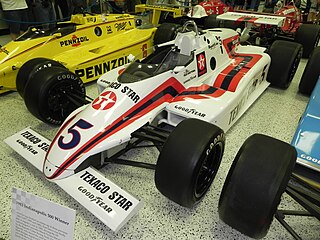
The 67th Indianapolis 500 was held at the Indianapolis Motor Speedway in Speedway, Indiana, on Sunday, May 29, 1983. After finishing second three times, winning the pole position twice (1977–1978), and being the fastest qualifier one additional time (1981), Tom Sneva finally shook his "bridesmaid" status and won his first and only Indianapolis 500. The win also represented the record seventh Indy victory that chief mechanic George Bignotti was involved with.
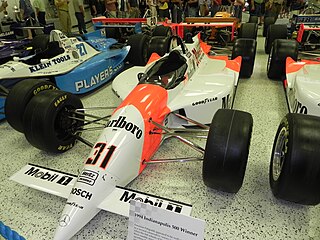
The 78th Indianapolis 500 was held at the Indianapolis Motor Speedway in Speedway, Indiana on Sunday, May 29, 1994. The race was sanctioned by United States Auto Club (USAC), and was included as race number 4 of 16 of the 1994 PPG IndyCar World Series. For the second year in a row, weather was not a factor during the month. Only one practice day was lost to rain, and pole day was only partially halted due to scattered showers. Warm, sunny skies greeted race day.
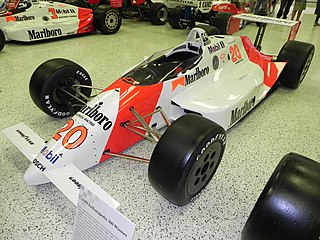
The 73rd Indianapolis 500 was held at the Indianapolis Motor Speedway in Speedway, Indiana on Sunday, May 28, 1989. The race was won by Emerson Fittipaldi, a two-time Formula One World Drivers' Champion. Fittipaldi became the first Indianapolis 500 winner from Brazil, the first foreign-born winner of the race since Mario Andretti in 1969, and the first non-American winner since Graham Hill in 1966. Though Fittipaldi started on the front row and dominated much of the race, he found himself running second in the waning laps. Michael Andretti passed Fittipaldi for the lead on lap 154, then led until his engine blew. Al Unser Jr. moved up to second, but trailed Fittipaldi by a big margin. Gambling on fuel mileage, Unser caught up to Fittipaldi after a fortuitous caution period on lap 181, and subsequently took the lead on lap 196.

The 72nd Indianapolis 500 was held at the Indianapolis Motor Speedway in Speedway, Indiana, on Sunday May 29, 1988. Team Penske dominated the month, sweeping the top three starting positions with Rick Mears winning the pole position, Danny Sullivan at the center of the front row, and Al Unser, Sr. on the outside. Mears set a new track record, becoming the first driver to break the 220 mph barrier in time trials. On race day, the three Penske teammates proceeded to lead 192 of the 200 laps, with Rick Mears taking the checkered flag, his third-career Indy 500 victory. The race represented the milestone 50th victory in Championship car racing for owner Roger Penske and Penske Racing.
The 1979 SCCA/CART Indy Car Series was the inaugural Championship Auto Racing Teams (CART) American open wheel racing championship series. The season consisted of 14 races. Rick Mears was the national champion, and the rookie of the year was Bill Alsup. The 1979 Indianapolis 500 was sanctioned by USAC, but counted towards the CART points championship. Rick Mears won the Indy 500, his first of four victories in the event.

The Pocono 500 was an IndyCar Series race held at Pocono Raceway in Long Pond, Pennsylvania, located in the Pocono Mountains. The first Indy car race at Pocono was held in 1971. It was the first major event held at the track, shortly after its completion. The race was sanctioned by USAC from 1971 to 1981, and then by CART from 1982 to 1989, and was known as the Pocono 500. The race was removed from the CART calendar following the 1989 running, due to poor track conditions, as well as poor revenue for the promoter.

The 1974 Pocono 500, the 4th running of the event, was held at the Pocono Raceway in Long Pond, Pennsylvania, on Sunday, June 30, 1974. Branded as the 1974 Schaefer 500 for sponsorship reasons, the race was won by Johnny Rutherford, who one month earlier won the 1974 Indianapolis 500.

The 1973 California 500, the fourth running of the event, was held at the Ontario Motor Speedway in Ontario, California, on Sunday, September 2, 1973. The event was race number 11 of 16 in the 1973 USAC Championship Car season. The race was won by Wally Dallenbach Sr., his only 500-mile Indy Car victory.

The 1976 California 500, the seventh running of the event, was held at the Ontario Motor Speedway in Ontario, California, on Sunday, September 5, 1976. The event was race number 10 of 13 in the 1976 USAC Championship Car season. The race was won by Bobby Unser, becoming the first man to win the California 500 twice. The race was also the first Indy Car race for Rick Mears.

















